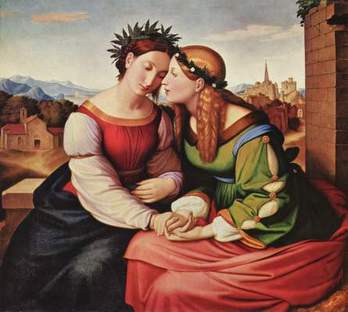The Nazarenes ~ Romantic Spirit and Christian Art

'Italia and Germania' by Johann Friedrich Overbeck
“A Nazarene!”
With their shoulder-length hair and their unusual habit of wearing long, flowing robes and sandals, a group of German artists attracted attention as they walked the streets of Rome in 1810, and were derisively christened with what was initially a pejorative nickname.
This artistic society had its beginnings at the The Academy of Fine Arts Vienna (Akademie der Bildenden Künste Wien) in 1808 when Friedrich Overbeck and Franz Pforr, two rebels against the academic style, began meeting with four other dissatisfied other students in revolt against neoclassicism and what they called the Academy's stifling methods. They were especially drawn to the works of Rafael and Perugino.
In 1809 they formally established what they called the Lucasbund, in honor of Saint Luke, the patron saint of painters. They chose the name deliberately to evoke memories of the medieval guilds.
They were influenced by the anti-Enlightenment ideas of Wilhelm Heinrich Wackenroder, co-founder with Johann Ludwig Tieck of the German Romantic movement, and author of a series of essays, Herzensergießungen eines kunstliebenden Klosterbruders (Outpourings of an Art-Loving Friar, 1797).
Wackenroder, who died in 1798 at the tender age of 24, belonged to a circle in Jena that included the brothers August and Friedrich Schlegel, the poet “Novalis” (Friedrich Hardenberg) and the philosopher Friedrich Schelling. It was Wackenroder's position that art can only be created by feeling and a spiritual connection and not through reason.
“Pforr, in particular, embraced Wackenroder's view that the contemplation of art ought to be a devotional exercise, a pietistic practice.”
Encyclopedia of the Romantic Era, 1760-1850, page 869
In addition, at the beginning of the 19th century a Catholic revival was sweeping across Europe in reaction against the excesses of the French Revolution.
In their day, the European-wide influence of The Nazarenes was significant. Today, while they are mostly unknown and unappreciated, the recognition of their efforts and contribution is slowing increasing. Columbia University Professor Cordula Grewe writes that "... any real understanding of European art's development in the nineteenth century must involve an understanding of the Nazarene movement and its place within this development."
Painting the Sacred in the Age of Romanticism by Cordula Grewe (2009)
Unwilling Moderns: The Nazarene Painters of the Nineteenth Century
The Nazarenes
With their shoulder-length hair and their unusual habit of wearing long, flowing robes and sandals, a group of German artists attracted attention as they walked the streets of Rome in 1810, and were derisively christened with what was initially a pejorative nickname.
This artistic society had its beginnings at the The Academy of Fine Arts Vienna (Akademie der Bildenden Künste Wien) in 1808 when Friedrich Overbeck and Franz Pforr, two rebels against the academic style, began meeting with four other dissatisfied other students in revolt against neoclassicism and what they called the Academy's stifling methods. They were especially drawn to the works of Rafael and Perugino.
In 1809 they formally established what they called the Lucasbund, in honor of Saint Luke, the patron saint of painters. They chose the name deliberately to evoke memories of the medieval guilds.
They were influenced by the anti-Enlightenment ideas of Wilhelm Heinrich Wackenroder, co-founder with Johann Ludwig Tieck of the German Romantic movement, and author of a series of essays, Herzensergießungen eines kunstliebenden Klosterbruders (Outpourings of an Art-Loving Friar, 1797).
Wackenroder, who died in 1798 at the tender age of 24, belonged to a circle in Jena that included the brothers August and Friedrich Schlegel, the poet “Novalis” (Friedrich Hardenberg) and the philosopher Friedrich Schelling. It was Wackenroder's position that art can only be created by feeling and a spiritual connection and not through reason.
“Pforr, in particular, embraced Wackenroder's view that the contemplation of art ought to be a devotional exercise, a pietistic practice.”
Encyclopedia of the Romantic Era, 1760-1850, page 869
In addition, at the beginning of the 19th century a Catholic revival was sweeping across Europe in reaction against the excesses of the French Revolution.
In their day, the European-wide influence of The Nazarenes was significant. Today, while they are mostly unknown and unappreciated, the recognition of their efforts and contribution is slowing increasing. Columbia University Professor Cordula Grewe writes that "... any real understanding of European art's development in the nineteenth century must involve an understanding of the Nazarene movement and its place within this development."
Painting the Sacred in the Age of Romanticism by Cordula Grewe (2009)
Unwilling Moderns: The Nazarene Painters of the Nineteenth Century
The Nazarenes
Franz Peter Schubert (1797-1828). Kyrie from Mass No. 2 in G major, D. 167
Robert Shaw, Atlanta Symphony Orchestra and Chamber Chorus
With paintings by artists of the "Nazarene Movement"
Joseph von Führich (1800-1876)
Peter von Cornelius (1784-1867)
Johann Friedrich Overbeck (1789- 1869)
Friedrich Wilhelm Schadow (1789-1862)
